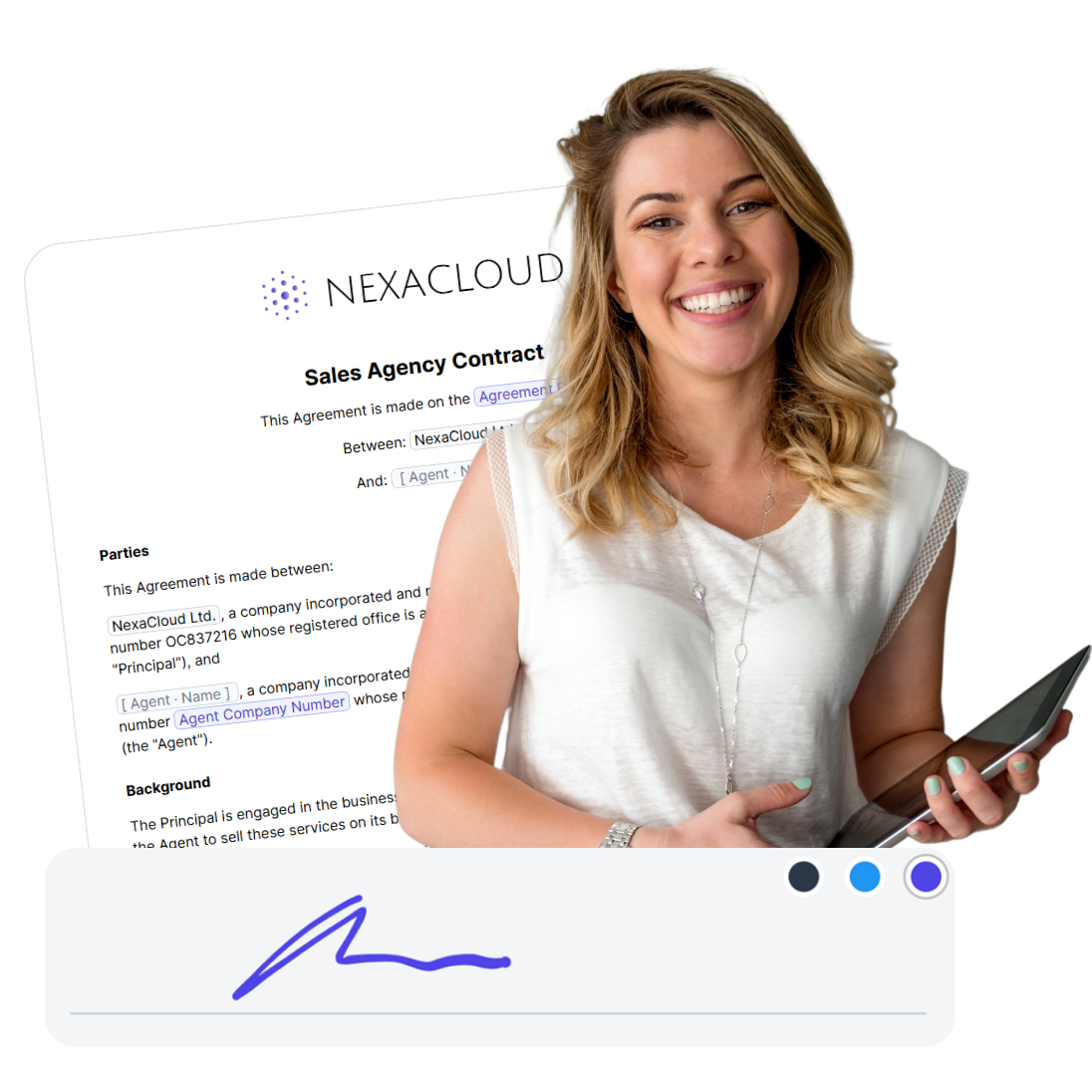The Complete Guide to Effective Contract Repository Management
A contract repository is where every agreement your business depends on finally finds its place. No cluttered folders, no endless searches, no guessing which version is the right one. It’s the organized brain of your operations, quietly keeping track of who promised what, when things renew, and what needs your attention next. When done right, contract repository management turns scattered documents into structured intelligence. It gives you instant clarity, real control, and a calm confidence that nothing important will ever slip through the cracks again. In this blog, you’ll learn what a contract repository is, how it works, why it matters, and what makes modern solutions like fynk stand out as the smarter way to manage every contract in one place.
- What is contract repository?
- Why centralized contract storage at all
- What types of contracts and data are stored in a contract repository?
- How does a contract repository differ from a document management system (DMS)?
- What are the main types of contract repositories available?
- Cloud-based vs. on-premise contract repositories
- How CLM-integrated repositories work?
- 6 Key features to look for when choosing a contract repository management tool
- How AI helps contract repository management
- How to set up a great contract repository
- Real-world contract repository use cases by department
- Common contract repository mistakes (and how to avoid them)
- fynk: Contract repository that does it all
- FAQs about contract repository management

TL;DR
- A contract repository is not just digital storage, it’s your control center for every business agreement.
- Centralizing contracts prevents version confusion, missed renewals, and compliance risks.
- Modern contract repository management systems use AI and automation to make contracts searchable, trackable, and actionable.
- Integrations connect your repository with tools like CRM, ERP, and e-signature platforms for a smoother workflow.
- A clean, well-structured repository saves time, reduces risk, and improves cross-team collaboration.
- The best solutions turn static files into insights by tracking obligations, alerting you to renewals, and helping you negotiate smarter.
- fynk bring it all together in one secure, easy-to-use platform built for real results.
What is contract repository?
A contract repository is your organization’s single source of truth for every contract you’ve ever signed or plan to sign. It’s usually a secure digital library where all agreements live, easily searchable, trackable, and organized. Unlike storing files across scattered folders or email threads, a contract repository is the only place that let you find what you need, when you need it, without using other tools.
The goal of contract repository management is visibility and control. It ensures that you, your team, and stakeholders can instantly access the latest version of any contract, check key dates like renewals or expirations, and see who’s responsible for what. Those companies that don’t have a central repository often face problems like lost documents, missed renewals, or inconsistent terms across agreements.
A modern contract repository (usually digital and with AI capabilities) are active systems, not a passive archive. They have metadata, version tracking, and integrations that make managing the full contract lifecycle easier.
Why centralized contract storage at all
Because scattered contracts cost money.
Every time a team member searches through emails or shared folders for “the latest version,” you’re losing time. Every time someone forgets to update a clause or track a renewal, you’re increasing risk. It’s invisible at first, but as your company grows, it gets even overwhelming.
In fact, studies show companies lose more than 9% of annual revenue because of poor contract visibility. That’s not a small number.
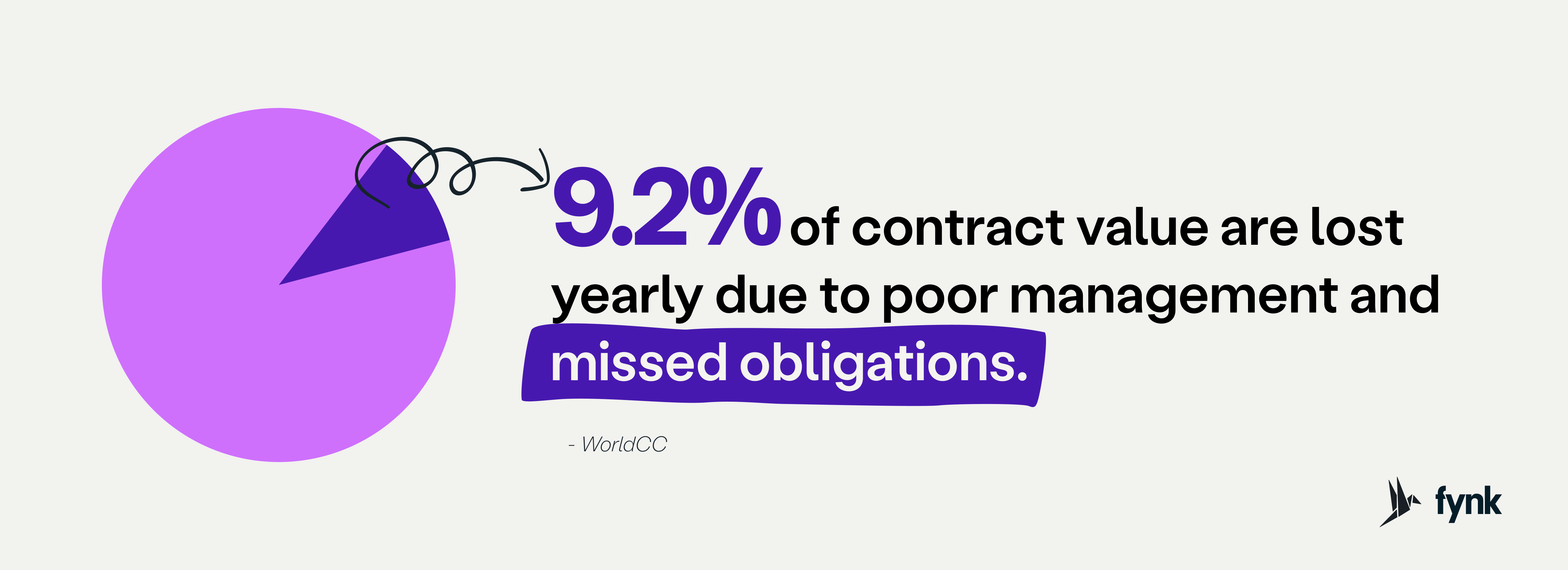


Having a central repository let you:
- Save time: All contracts are in one place, easy to find and access instantly.
- Stay consistent: Everyone works on the same version, no mix-ups or duplicate files.
- Avoid missed deadlines: Renewal and expiry alerts keep you ahead of key dates.
- Gain visibility: See every active contract, its value, and owner at a glance.
- Enjoy automation and AI: Centralization is the foundation for automation, analytics, and better decisions.
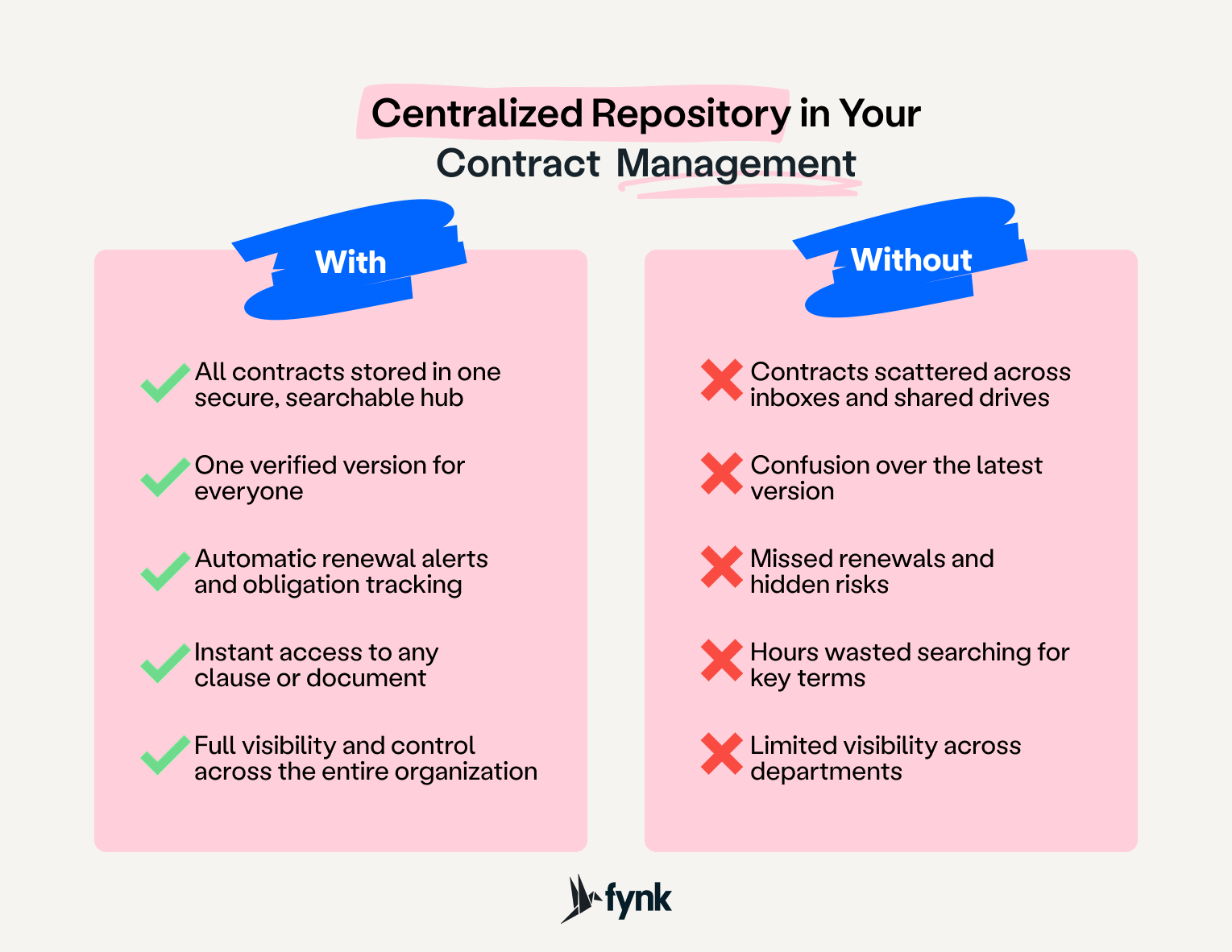


What types of contracts and data are stored in a contract repository?
Not only a contract repository holds all your signed agreements, it’s also a complete record of your business relationships.
Here’s what typically lives inside:
- Commercial and vendor contracts: purchase agreements, supplier terms, NDAs, and service-level agreements (SLAs).
- Customer contracts: sales of goods agreements, subscription terms, and statements of work.
- Employment and HR contracts: job offers, NDAs, non-competes, and contractor agreements.
- Partnership and investment agreements: joint ventures, equity deals, and shareholder documents.
- Real estate and asset contracts: leases, licenses, and property-related agreements.
Apart from documents, your repository also stores vital data that makes those contracts useful:
- Key dates (start, end, renewal, termination)
- Contract values and payment terms
- Obligations, deliverables, and milestones
- Linked entities like vendors or customers
- Custom tags and metadata for quick search
The good thing about having all these data stored in one place, is that it gives you insights that you wouldn’t have accessed before. For example, by combining these data you’ll find out about:
- Which vendors consistently miss deadlines or breach terms
- Which contracts bring the most revenue or the least value
- How much risk is tied to upcoming renewals or expiring agreements
- Where negotiation terms can be improved across future contracts
- How contract performance aligns with company goals
How does a contract repository differ from a document management system (DMS)?
The main difference between contract repository and a DMS is that contract repository knows what it’s store in them and works with teh storage data, but DMS just stores them, it doesn’t care about the content.
At first glance, they seem almost identical.
- Both store documents.
- Both offer search functions.
- Both help teams stay organized.
But what they do and what they unlock is totally different.
Let’s start with the DMS: A Document Management System (DMS) is basically your digital filing cabinet. It’s built for general file storage like reports, PDFs, images, presentations… all the usual stuff.
You can upload, share, and version documents. It’s solid for staying organized.
But that’s where it stops. A DMS doesn’t care what’s inside those files. It’s not built to understand contracts or the business value packed into them.
A contract repository, on the other hand is purpose-built for contracts.
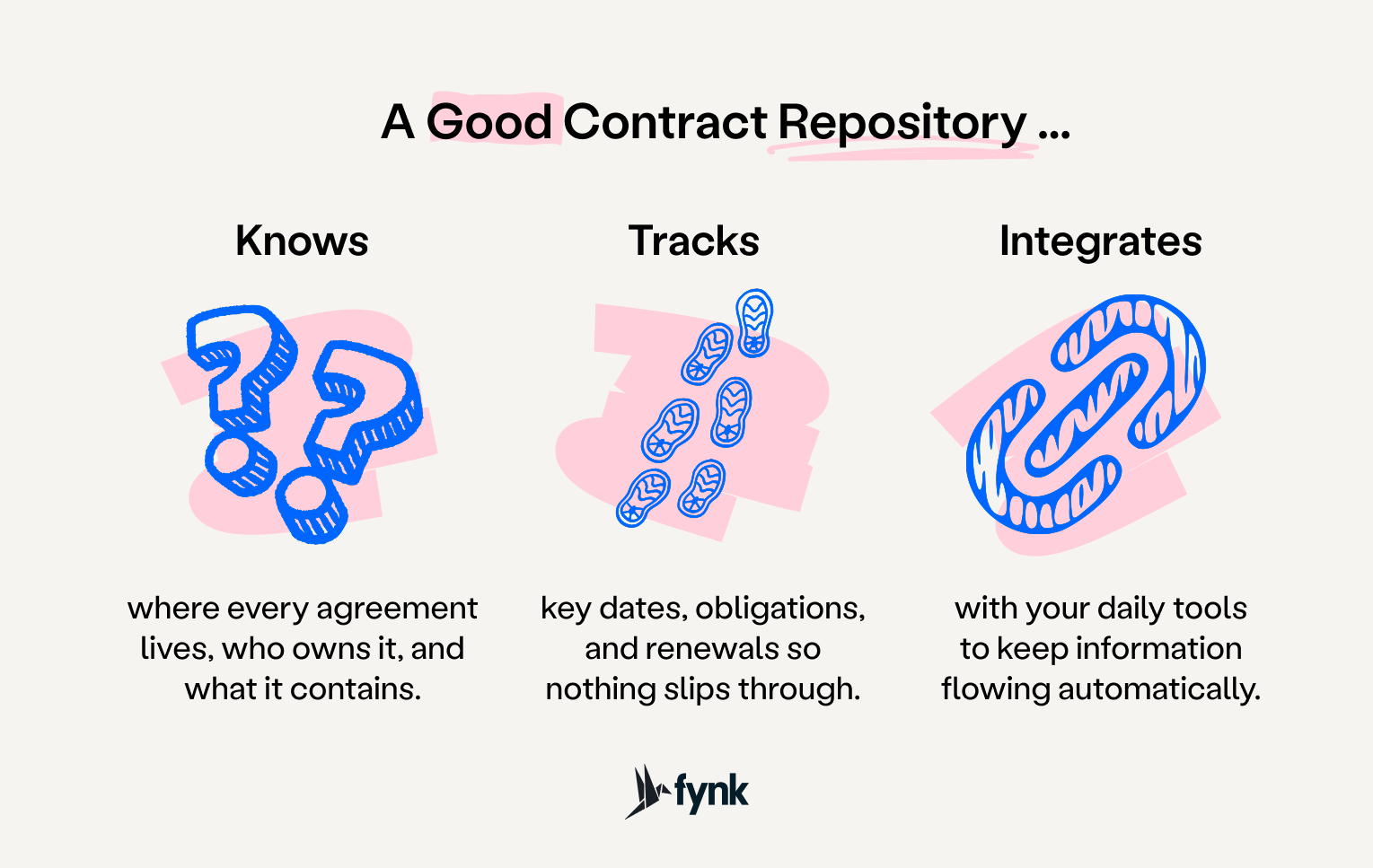


- It knows what a renewal date is.
- It tracks obligations, counterparties, key terms.
- It integrates with your workflows like legal, finance, procurement, so nothing slips through.
In short:
| Feature | Document Management System (DMS) | Contract Repository |
|---|---|---|
| Primary Purpose | Store and organize all file types | Manage and analyze contracts |
| Data Type | Files and folders | Contracts, metadata, obligations, key terms |
| Search | Basic keyword or filename | Search by clauses, parties, dates, terms |
| Alerts | Rare (if any) | Renewal, expiry, compliance alerts |
| Integrations | General (email, cloud drives) | Tailored to CLM, CRM, ERP, e-signature tools |
| Insight Level | Surface-level organization | Deep analytics and reporting |
What are the main types of contract repositories available?
Not all contract repositories are built the same. The right setup depends on how your team handles contracts right now, and how much smarter you want that process to be down the line.
Here’s the breakdown:
1. Basic digital storage
Example includes: Google Drive, SharePoint, Dropbox.
It’s a shared folder setup, better than letting contracts rot in inboxes, but still pretty bare-bones.
- No structure
- No advanced search
- No automation
✅ Good for: Early-stage teams
⚠️ Limitations: Gets messy fast as volume grows
2. Standalone contract repository software
A solid step up. These tools are designed specifically for contracts and not just general files.
They let you:
- Centralize all agreements
- Tag with metadata
- Search by party, term, or clause
- Track key dates and deadlines
✅ Good for: Teams ready for better visibility and basic control
⚠️ Limitations: Doesn’t cover the full contract lifecycle
3. Integrated CLM repositories
This is the best type*.*
These platforms combine storage with full-blown contract lifecycle management (CLM):
- Drafting
- Negotiation
- E-signature
- Approval workflows
- Renewal alerts
- AI insights
✅ Good for: All businesses, especially small and scaling teams that need automation, visibility, and control
4. Industry-specific repositories
Built for sectors like healthcare, construction, or finance where compliance is super important.
These systems often come with:
- Pre-built templates
- Industry-standard fields
- Built-in regulatory checks
✅ Good for: Highly regulated industries
⚠️ Limitations: May be too narrow for general use
So… what’s the right move?
- Managing a few contracts? → Basic storage might do the trick (for now).
- Juggling more? → Go with an integrated CLM repository.
Cloud-based vs. on-premise contract repositories
When you’re picking a contract repository, one of the biggest choices is where it lives:
- In the cloud, hosted by a provider
- Or on-premise, on your company’s own servers
Both have their perks but the real difference is in flexibility, control, and how much hassle you’re willing to take on.
Option A: Cloud-Based repositories
These are the modern standard and for good reason.
- Hosted online, accessed via secure web browser
- Fast setup, no installation headaches
- Automatic updates (no IT team needed)
- Built to scale as you grow
- Accessible from anywhere and perfect for remote teams
Oh, and most AI-powered contract tools today? Cloud-only.
Option 2: On-Premise repositories
Old-school, but still useful in some scenarios.
- Installed on your own servers
- Popular in highly regulated industries (like finance or government)
But it comes at a cost:
- Manual updates
- More IT maintenance
- Slower to scale
- Higher upfront investment
So, which option is better?
If you’re looking for speed, simplicity, and lower overhead, cloud is the clear winner.
If you need to have the IT muscle to support it, on-prem might still make sense.
Worried about security?
Today’s top cloud providers meet gold-standard certifications like ISO 27001 and SOC 2, meaning they’re just as (if not more) secure than what most teams can manage in-house.
Since CLM-integrated repositories is the best choice when you’re dealing with contracts, let’s take a closer look at them.
How CLM-integrated repositories work?
The secret sauce of CLM-integrated repository is automation. Instead of being a passive place to file documents, it becomes the command center for your entire contract lifecycle from creation to renewal.
Here’s how that looks in reality:
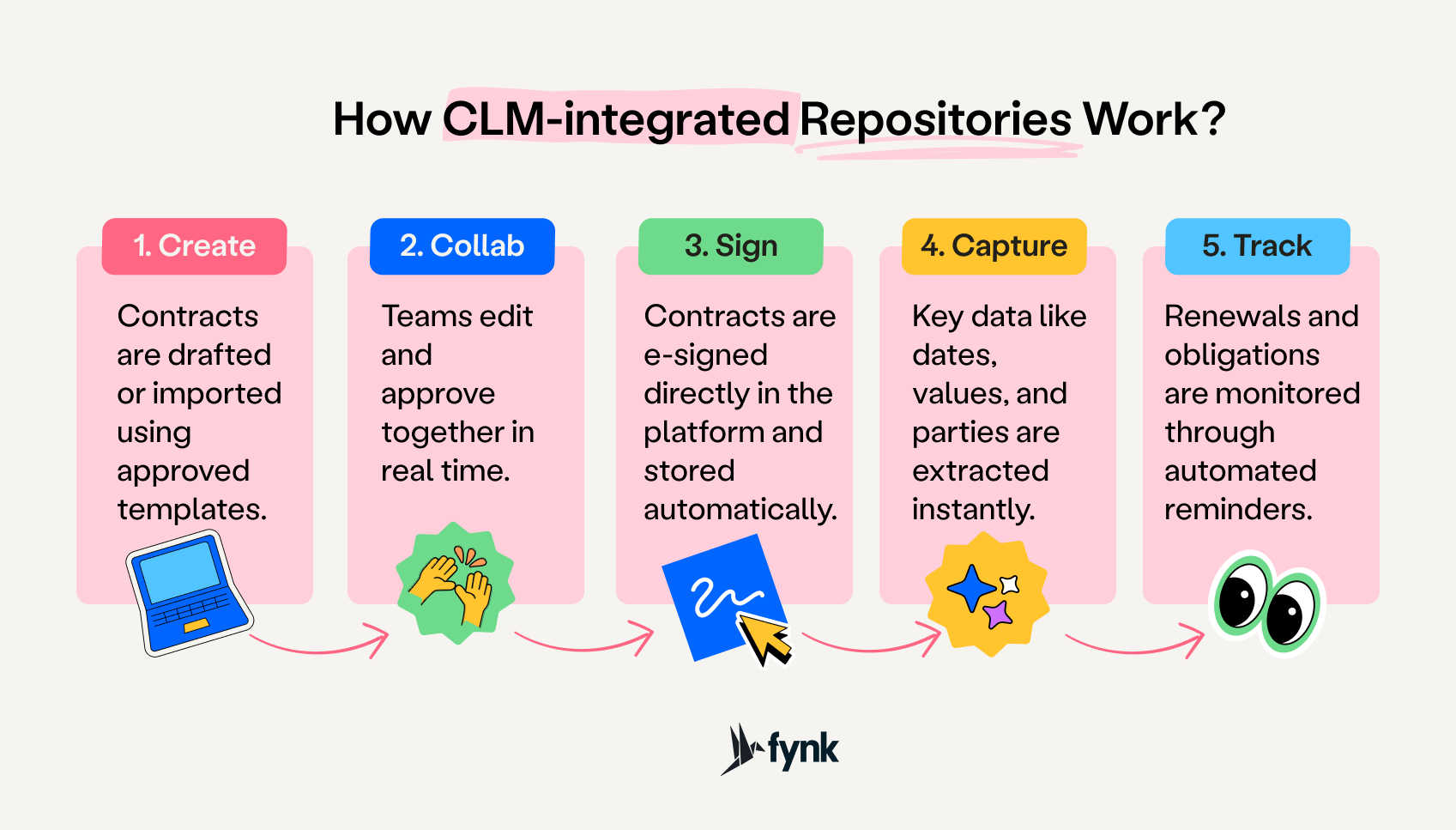


1. Contracts are created directly in the system (or by import)
Users start with pre-approved templates or draft the documents directly in editor, so every draft follows company standards and stays compliant from the beginning.
2. Collaboration happens in real time.
Legal, sales, and other teams can review, edit, and approve the same document without bouncing versions back and forth over email.
3. Digital signatures are built in.
Once a contract is approved, it’s sent for e-signature straight from the platform. As soon as it’s signed, it’s automatically stored in the repository. No manual uploads. No missing files. No version mix-ups.
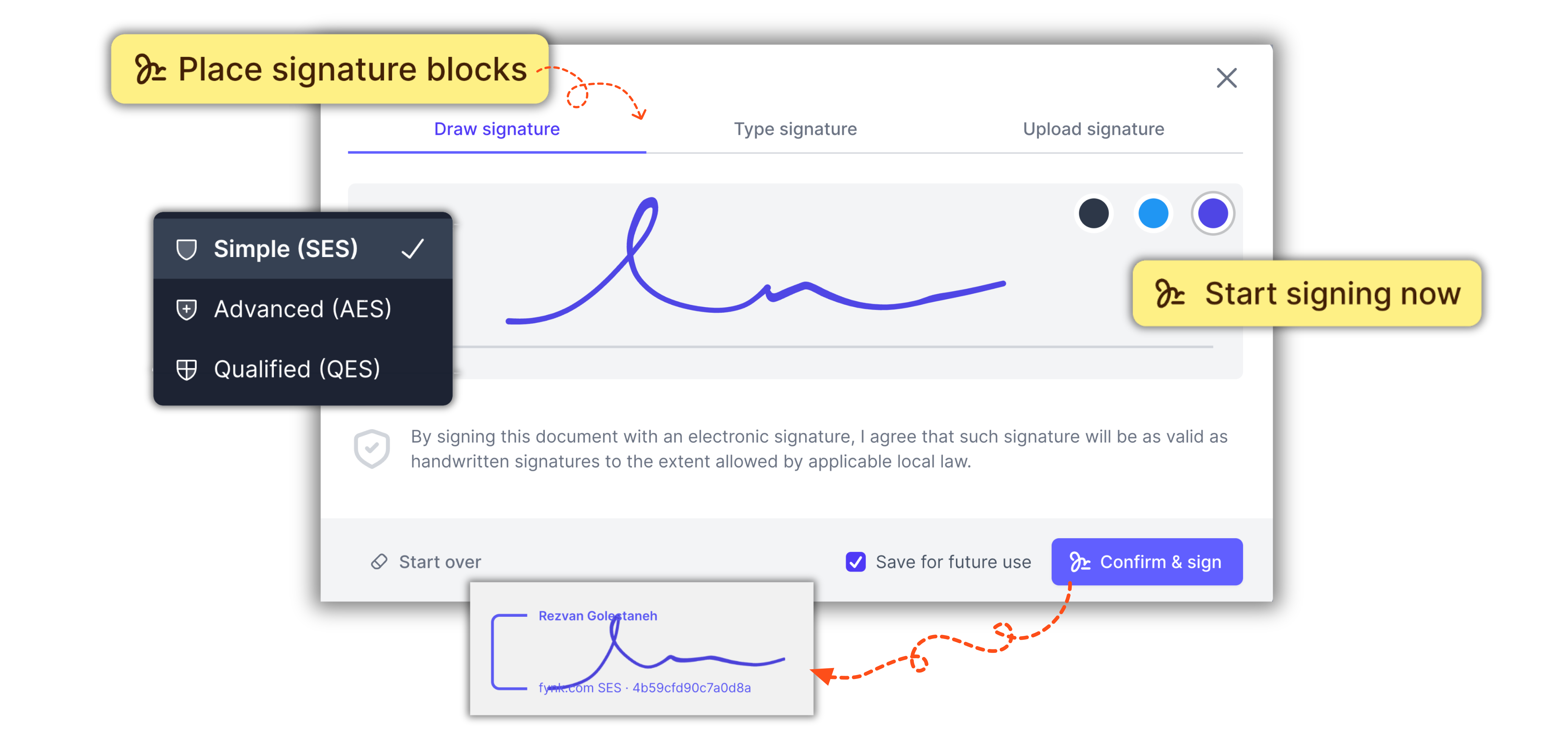


Electronic Signatures in fynk
4. Key data is captured automatically.
The system pulls out essential info like renewal dates, contract value, and counterparties. That turns a static PDF into searchable, actionable data.
5. Renewals and obligations are tracked.
Automated workflows and reminders keep everything moving. Nothing gets lost. Nothing gets missed.
As you can see, a CLM-integrated repository brings everything under one roof. It’s where contracts live, interact, move, and managed.
6 Key features to look for when choosing a contract repository management tool
Expert Edition, because you’re not here for the basics:
1. Advanced search and clause-level querying 🔎
Let’s be real: basic keyword search for documents is ancient tech.
What you need is semantic search and clause-level visibility. The best tools don’t just find “termination,” they are also able to find the exact clause that says “termination for convenience” or “auto-renewal.”
That’s a game-changer for:
- Due diligence
- Audit prep
- Risk reviews
Bonus: Filters like counterparty, risk rating, or governing law can turn contract analysis from a weeklong slog into a two-minute power move.
2. Metadata tagging and smart classification 🧠
Manual tagging? Great… if you like errors.
A good CRM use AI-based metadata extraction to automatically pulling in:
- Contract type
- Party names
- Currency
- Renewal terms
- Key dates
The goal here is not just staying organized, but also fueling automation possibilities.
For example: When a renewal date is approaching, an automated reminder will be send two week in advanced.
Most of the smart and wonderful things that you can do with a repository is thanks to metadata, so make sure the CLM you choose has this!
3. Role-based access and user permissions 👥
Your contract repository should mirror your organization chart.
- Legal needs full visibility.
- Finance? Just payment data.
- Sales? Maybe just renewal terms.
Role-based permissions keep access clean and edit-proof.
When looking for a repository, look for platforms that log every click, edit, or download. That audit trail is the one thing that can save you in a compliance audits.
4. Integrations with legal, procurement, and CRM tools 🔗
Disconnected systems = silent killers.
If your contract data’s stuck in silos, the whole business slows down.
You want a repository that plugs into:
- Your CLM
- Your CRM (like Salesforce integrations)
- E-signature tools (better if the CRM itself provide it)
- ERP (Enterprise Resource Planning) systems
Why? So you can:
- Auto-create contracts from deals
- Track renewals in real-time
- Pull reports across teams without spreadsheets
5. Security, compliance and audit trails 🔒
If your CLM is not secure, it’s not worth it.
The gold standard to look for are these:
- ✅ SOC 2
- ✅ ISO 27001
- ✅ GDPR compliance
- ✅ Role-based encryption
And don’t skip on immutable audit logs, meaning: nobody can delete or edit them. When audit season hits, this is the feature that saves you.
6. Customizable dashboards and contract analytics 📊
Dashboards are where strategy happens.
Except from contract counts, you want real intel into:
- Contract value by vendor
- Upcoming renewals
- Compliance gaps
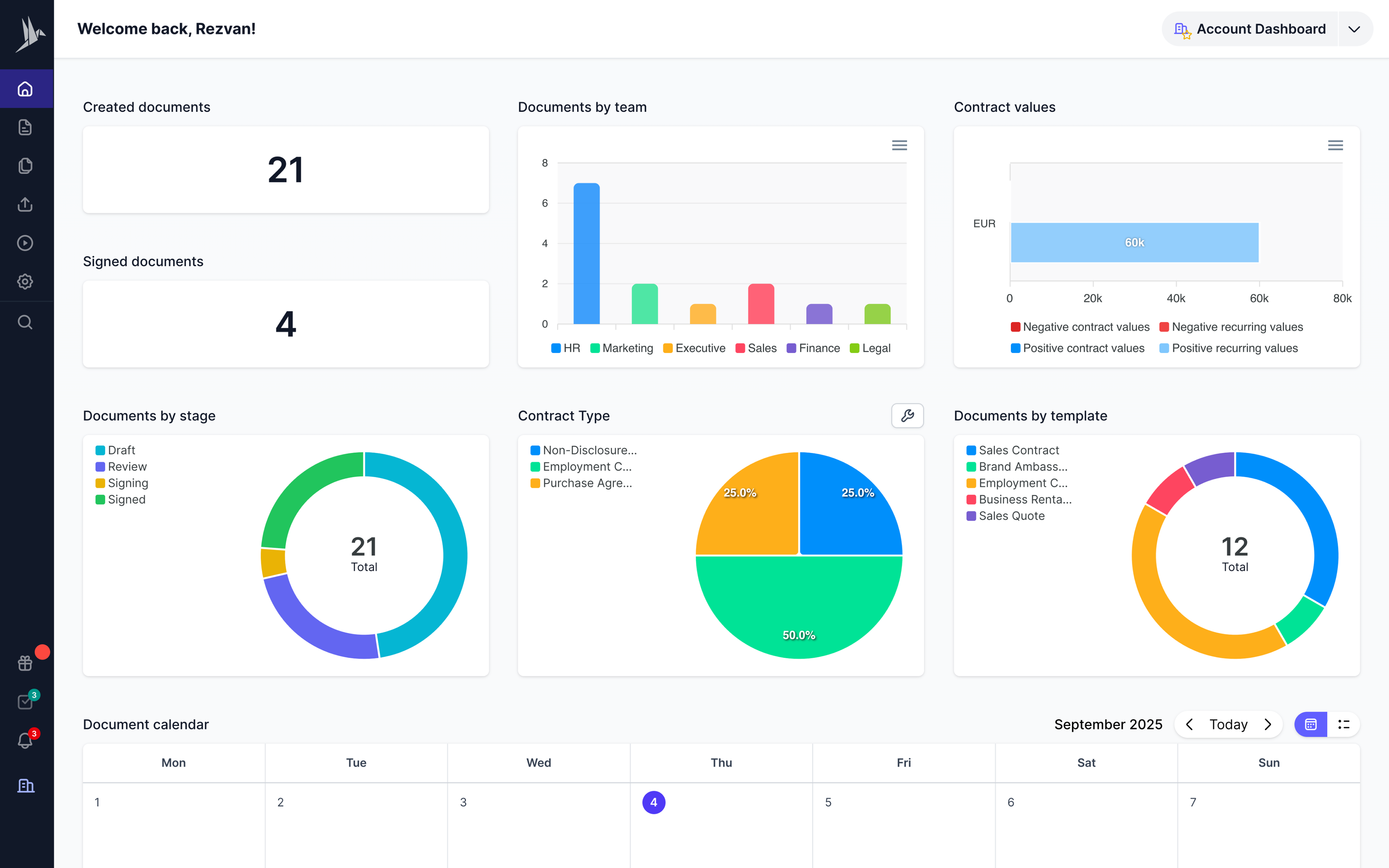


fynk user dashboard
How AI helps contract repository management
Just like anything else these days, contract repository management too is affected by AI. here’s how AI can help you with managing contracts in your repository:
1. Automated data extraction
AI automatically extracts key contract data as soon as a document is uploaded. This eliminates manual input and improves data accuracy across the system.
AI can identify and extract:
- Contract parties
- Effective and renewal dates
- Clauses (e.g., termination, indemnity)
- Payment terms and financials
- Contract types and governing law
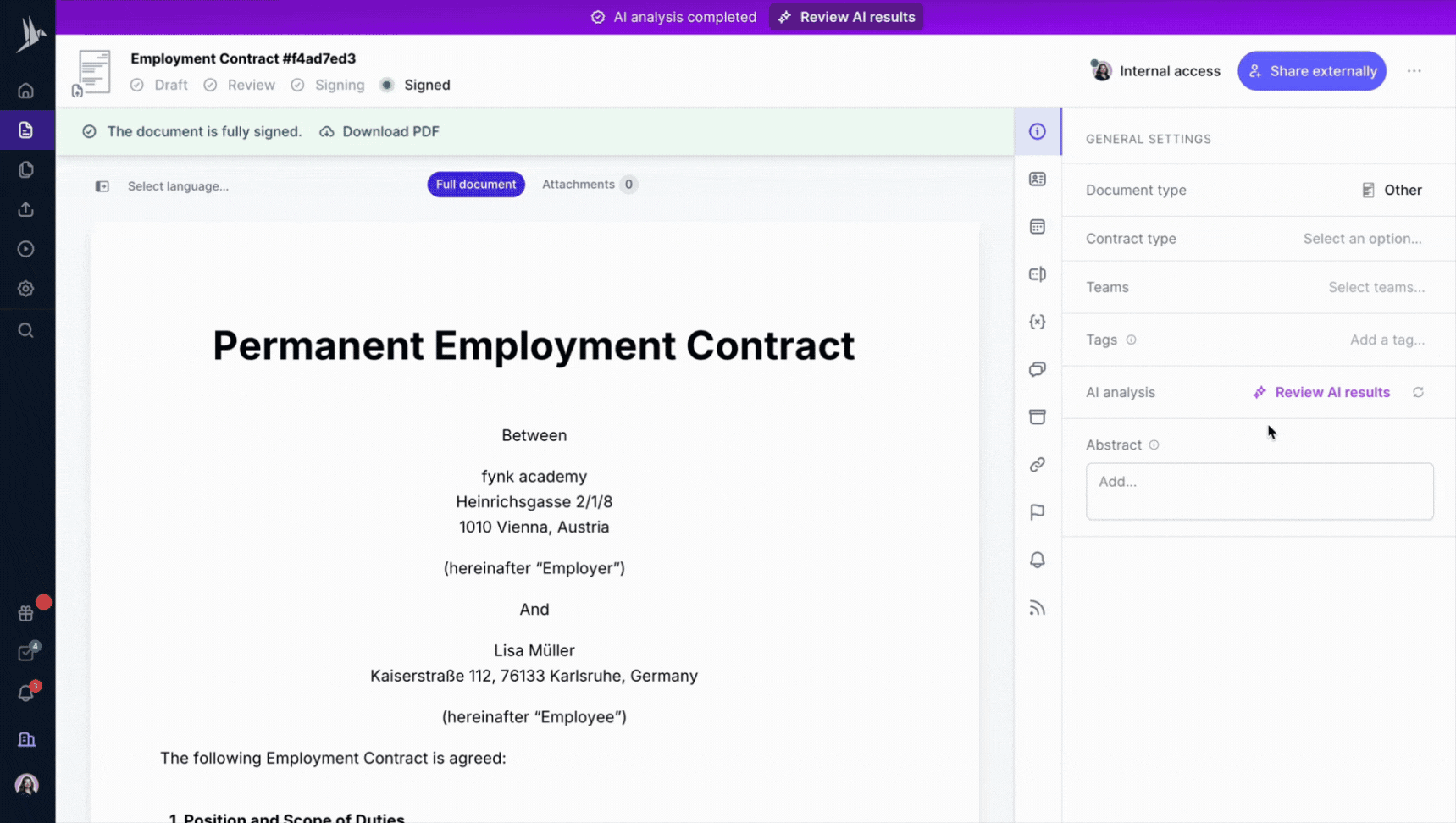


AI analysis and metadata extraction in fynk
2. Context-Aware Search
Unlike basic keyword search, AI understands intent. You can ask things like:
“Show me contracts with automatic renewal clauses” or “Find NDAs without termination dates,” and it will locate them, even if the wording varies.
It’s more accurate, more intuitive, and much faster.
3. Renewal and Obligation Tracking
AI can detect when a contract is approaching renewal or an obligation is due, and trigger timely alerts or assign tasks. This helps prevent missed deadlines and improves coordination between legal, procurement, and business teams.



Notification and reminders settings in fynk
4. Clause Comparison and Risk Detection
AI can review clauses across your contracts to:
- Flag non-standard or high-risk language
- Suggest preferred alternatives
- Identify gaps or inconsistencies
How to set up a great contract repository
Buying software is easy. Building a contract repository people actually use and trust? That takes a little more strategy.
Here’s how to do it right, from setup to long-term success.
🔍 Step 1: Map what you’ve got
Before you centralize anything, figure out where your contracts currently live:
- Shared drives
- Email threads
- Legacy systems
- (Yep, even filing cabinets)
Then ask:
What should be moved? What can be archived?
Next, define a clear structure:
- By department?
- By vendor or client?
- By contract type?
There’s no one-size-fits-all, but whatever you choose, keep it consistent.
Also:
Set naming rules. Assign ownership.
Without clear roles, even the best system falls apart fast.
📦 Step 2: Migrate legacy contracts (the right way)
This is where most teams underestimate the lift. Start with a contract audit:
- Spot duplicates
- Flag missing docs or signatures
- Archive what’s expired
Then digitize any paper agreements, extract key metadata (start date, end date, renewal terms), and upload them.
✨ Pro tip: Use AI tools to auto-tag and classify during upload. Remember that cleaner data now means better insights later.
🗂️ Step 3: Standardize templates and structure
Want a clean, usable contract repository long-term? You need structure and standardization.
Start by setting up common tags or folders like:
- Sales
- Procurement
- HR
- Legal / Compliance
Each category should include:
- A clear naming system
- Pre-approved templates
- Standard clauses
This keeps your content organized and reduces legal risk.
👥 Step 4: Train your teams (without boring them)
Your system’s only as good as the people using it. Run short, practical training sessions and focus on real benefits:
- “Here’s how to find that NDA in 10 seconds.”
- “This is how to set a renewal reminder.”
- “Look how easy it is to pull a report.”
Then assign a champion in each department, someone who can answer questions and keep adoption moving. Show people the value, and usage takes care of itself.
♻️ Step 5: Keep it clean (and evolving)
This isn’t a “set it and forget it” system.
- Review data quarterly
- Archive expired contracts
- Refresh templates as policies shift
- Check access permissions regularly
- Automate what you can
- Track usage to see what’s working (and what’s not)
Small, consistent improvements keep the whole system tight and keep your team confident it’s the single source of truth.
Real-world contract repository use cases by department
Legal team
For legal teams, the repository is both shield and spotlight. It protects the company from risk while giving lawyers full visibility over active obligations and pending renewals.
Legal can quickly:
- Search all contracts by clause, governing law, or counterparty
- Track obligations and compliance status automatically
- Review non-standard language flagged by AI
- Generate reports for audits or board meetings in minutes
Procurement and vendor management
Procurement teams handle dozens of vendor agreements, renewals, and service terms. A centralized repository helps them:
- Track supplier performance and contract value
- Compare terms across vendors to improve negotiation leverage
- Set reminders for renewals or performance reviews
- Ensure that only approved suppliers and terms are used
Finance and compliance
For finance, contracts are the roadmap of cash flow. A repository gives them instant access to payment terms, renewal dates, and value commitments. They can:
- Identify recurring costs or upcoming renewals
- Match contract terms to invoices for better accuracy
- Track financial exposure and forecast obligations
- Support audits with verifiable, time-stamped records
HR, sales, and operations
HR deals with employment contracts, NDAs, and contractor agreements. With a repository, they can quickly verify terms, renewals, and employee obligations without digging through files.
Sales teams rely on contract repositories to:
- Track deal status and renewal opportunities
- Pull the latest contract templates instantly
- Align pricing and terms with approved company policies
Common contract repository mistakes (and how to avoid them)
Treating the repository as a legal-only tool
Many companies position the repository under Legal and forget that contracts touch every department. When only lawyers use it, other teams keep working with their own files and spreadsheets, defeating the purpose of centralization.
How to avoid it:
Frame the repository as a business-wide system, not a legal archive. Involve finance, procurement, and sales during setup, and define shared workflows that connect everyone’s needs.
Overlooking integration capabilities
A contract repository that doesn’t connect to your other systems quickly becomes a dead end. If it doesn’t sync with tools like CRM, ERP, e-signature, or procurement software, you’ll end up re-entering the same data over and over.
👉 How to avoid it:
Choose a repository that integrates with your core business systems. This keeps data aligned across departments and ensures everyone is working with the same information.
Ignoring user permissions and security settings
Letting everyone access everything might seem convenient until someone downloads or edits a contract they shouldn’t. Security lapses like that can expose sensitive data or even breach compliance rules.
👉 How to avoid it:
Set clear role-based permissions. Limit access to sensitive contracts, and make sure every action (like edits or downloads) is logged in an audit trail.
Lack of renewal and expiry automation
Manual tracking is one of the fastest ways to lose control. Missed renewals or expirations can lead to financial losses or service interruptions.
👉 How to avoid it:
Automate reminders for key dates like renewals, expirations, and obligations. Make sure the system sends alerts well in advance — not after the fact.
fynk: Contract repository that does it all
If you’ve made it this far, you already know what great contract repository management should look like: organized, automated, and connected across your entire business. That’s exactly what we built in fynk.
fynk combines contract repository management, automation, and AI-powered insights in one clean, easy-to-use platform. It helps you manage them intelligently from creation to renewal.
Here’s what makes it stand out:
- Centralized, smart storage that gives every department/user based access to the right contract version instantly.
- AI-powered data extraction that identifies key dates, clauses, and obligations the moment a document is uploaded.
- Automated alerts and workflows that make missed renewals and manual tracking a thing of the past.
- Endless automations:
- Full visibility and analytics so you can track contract value, risk exposure, and performance across teams.
- Fast adoption and clean design that make it easy for everyone, not just legal, to use it from day one.
fynk Contract Repository Functionalities Overview
| Functionality | What It Covers |
|---|---|
| ✅ Centralized contract storage | Keeps all contracts and related documents in one secure, organized hub accessible to every authorized team member. |
| ✅ Advanced search & clause-level querying | Allows quick searches across contracts by keyword, clause type, or metadata to instantly find the information you need. |
| ✅ AI-powered data extraction | Automatically identifies and tags key contract details such as dates, parties, amounts, and obligations. |
| ✅ Metadata tagging & smart classification | Sorts and categorizes contracts by department, type, or counterparties for structured and consistent organization. |
| ✅ Automated renewal & obligation tracking | Sends reminders for expirations, renewals, and key deliverables so nothing is missed. |
| ✅ Role-based access control | Assigns permissions by role or department, ensuring users only access what they need. |
| ✅ Integration with business tools | Connects seamlessly with CRM (Salesforce), Slack, e-signature, and other business systems for unified workflows. |
| ✅ Custom templates & clause libraries | Lets teams create and manage standardized templates and approved clauses for faster, compliant drafting. |
| ✅ Collaboration & approval workflows | Supports multi-user editing, internal comments, and version control for transparent collaboration. |
| ✅ Secure storage & compliance | Uses encryption at rest and in transit (fynk does both) with full compliance to ISO 27001, SOC 2, and GDPR. |
| ✅ Audit trails & activity tracking | Records every action taken on a contract, including edits, approvals, and downloads, for full accountability. |
| ✅ Custom dashboards & analytics | Provides visual insights into contract volume, renewal pipeline, values, and risk exposure. |
| ✅ Scalable architecture | Designed to support any business size — from startups to large enterprises with thousands of contracts. |
| ✅ Fast onboarding & migration tools | Simplifies importing legacy contracts with AI-assisted tagging and data mapping. |
| ✅ Mobile and remote accessibility | Enables secure access to contracts from any device or location for hybrid and remote teams. |
The best part? You can try it for free:
Searching for a contract management solution?
Find out how fynk can help you close deals faster and simplify your eSigning process – request a demo to see it in action.
FAQs about contract repository management
- What’s the best way to measure the ROI of a contract repository?
- Track the time saved in finding contracts, the reduction in missed renewals, and the improvement in approval speed. These efficiency gains often pay for the system within months.
- How often should a contract repository be audited?
- At least twice a year. Review data accuracy, access rights, and contract versions. Regular cleanups prevent clutter and keep the system reliable.
- Can a contract repository handle non-legal documents like policies or RFPs?
- Yes. As long as they’re related to contract workflows. Storing all supporting materials in one place gives better context for future negotiations.
- What happens if we migrate incomplete or low-quality data?
- Poor data breaks search, automation, and reporting. Always clean up and validate your data before importing anything into the new system.
- Is a contract repository useful if we already have a CLM?
- Yes. The repository is the foundation of every CLM platform. Without a structured repository, your CLM can’t manage or automate effectively.
- Who should actually own the contract repository internally?
- Ownership should be shared. Legal manages compliance and structure, while Operations or Legal Ops ensures accuracy, integration, and adoption.
- What’s the biggest mistake companies make after going digital?
- They stop maintaining the system. Without regular updates, reviews, and clear ownership, a repository quickly turns into digital clutter.
- Can AI misread or misclassify contracts?
- It can, especially with scanned PDFs or poor formatting. Always review AI-extracted data at first. The system improves as it learns from corrections.
- How secure is cloud-based contract storage really?
- When done right, it’s very secure. Look for vendors with end-to-end encryption, ISO 27001 certification, and detailed audit logs. Most breaches come from weak access controls, not the cloud itself.
- Can contract data from the repository feed into business forecasting?
- Yes. Integrated repositories can sync with BI tools, helping you forecast renewals, revenue, and risk exposure more accurately.
- Can small businesses benefit from contract repository software?
- Absolutely. Even a small company deals with multiple contracts such as vendors, clients, freelancers, and leases. A repository prevents missed renewals, improves organization, and saves legal costs as you grow.
- What’s the difference between CLM and contract repository software?
- A contract repository focuses on storing and organizing contracts. A CLM (Contract Lifecycle Management) platform covers the full process including creation, negotiation, signing, storage, and renewal. In short, a repository is the core of a CLM system.
- Is AI safe and compliant in contract repositories?
- Yes, when implemented responsibly. Modern systems use secure, compliant AI models that process data within strict privacy frameworks. Look for solutions aligned with GDPR, SOC 2, and ISO 27001 standards.
- How scalable are repository solutions for large enterprises?
- Highly scalable. Cloud-based systems can handle thousands of users and millions of contracts without slowing down. What matters is choosing a platform that supports multi-entity structures, advanced search, and granular permissions.
- Can repositories handle different document formats like scanned PDFs, Word, and XML contracts?
- Yes. Modern repositories are built to process multiple document formats. They can read and index Word, PDF, and even image-based scanned files using OCR (Optical Character Recognition) technology. Advanced systems can also extract data from structured files such as XML contracts, allowing for both human-readable and machine-readable management.
- How is data encrypted in transit and at rest in modern repositories?
- Modern contract repositories use strong encryption standards to protect your data both in transit and at rest. This means your files are encrypted when stored on the server and also while being transmitted between systems. fynk follows this best practice by applying encryption at both levels, ensuring complete end-to-end data protection.
- How is fynk different from traditional contract repository software?
- fynk goes beyond simple storage. It combines a centralized contract repository with automation, AI data extraction, and real-time analytics. This means you don’t just store contracts — you manage their entire lifecycle, from drafting to renewal, all in one intuitive platform.
- Does fynk work for both small teams and large enterprises?
- Yes. fynk is built to scale. Small teams can start quickly with prebuilt templates and automation, while larger organizations can customize permissions, workflows, and integrations to fit complex structures.
- Can fynk integrate with our existing tools like Salesforce, Slack, or ERP systems?
- Yes. fynk connects seamlessly with popular tools like Salesforce, Slack, and major ERP systems. These integrations keep data synchronized across departments and remove the need for manual updates or duplicate entries.
- Does fynk provide analytics or contract performance insights?
- Yes. fynk includes built-in analytics dashboards that show total contract value, renewal timelines, and risk exposure. You can track KPIs and gain real-time visibility into how your contracts impact your business performance.
- How fast can we set up fynk for our organization?
- Setup is quick and straightforward. Most teams can start managing contracts within days. fynk’s guided onboarding and intuitive interface make it easy to import data, customize workflows, and train users with minimal effort.
- Can we migrate existing contracts into fynk easily?
- Yes. fynk supports bulk uploads and AI-assisted data extraction, so you can migrate existing contracts quickly without losing key information. The system automatically tags metadata and classifies contracts during import.
Please keep in mind that none of the content on our blog should be considered legal advice. We understand the complexities and nuances of legal matters, and as much as we strive to ensure our information is accurate and useful, it cannot replace the personalized advice of a qualified legal professional.

Table of contents
- What is contract repository?
- Why centralized contract storage at all
- What types of contracts and data are stored in a contract repository?
- How does a contract repository differ from a document management system (DMS)?
- What are the main types of contract repositories available?
- Cloud-based vs. on-premise contract repositories
- How CLM-integrated repositories work?
- 6 Key features to look for when choosing a contract repository management tool
- How AI helps contract repository management
- How to set up a great contract repository
- Real-world contract repository use cases by department
- Common contract repository mistakes (and how to avoid them)
- fynk: Contract repository that does it all
- FAQs about contract repository management
Want product news and updates? Sign up for our newsletter.
Other posts in Contract-Management

SaaS contract management explained for buyers and vendors
If you work in SaaS, you know how quickly contracts can pile up. Each one comes with its own terms, renewals, …
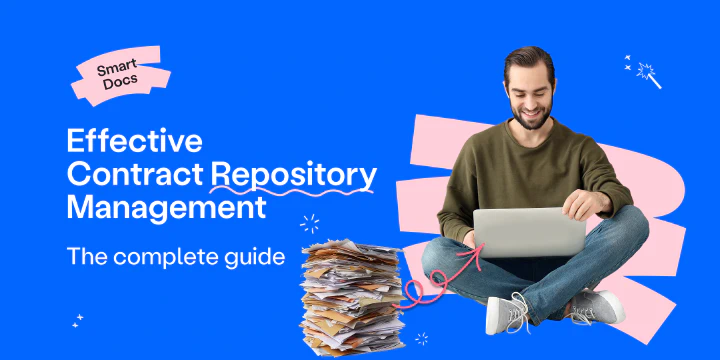
The Complete Guide to Effective Contract Repository Management
A contract repository is where every agreement your business depends on finally finds its place. No cluttered …
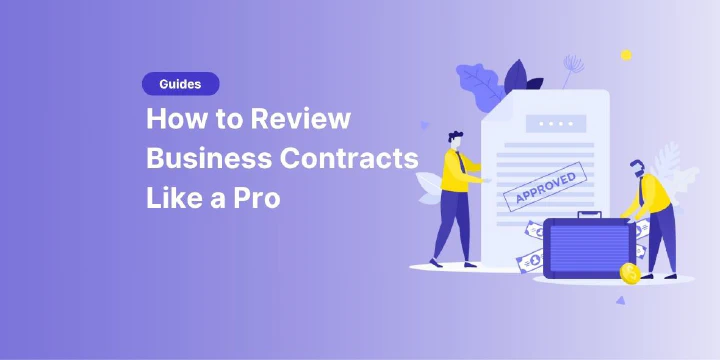
How to Review Business Contracts Like a Pro in 2025
When it comes to business contracts, what you don’t catch can hurt you. That’s why reviewing a business …
Contracts can be enjoyable. Get started with fynk today.
Companies using fynk's contract management software get work done faster than ever before. Ready to give valuable time back to your team?
Schedule demo

